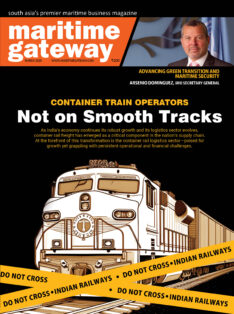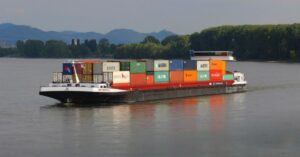When the DPD and DPE were introduced, initially there was commotion and later subsequently we got in terms with the changing regulatory systems and so now I would like to know what is the status of the DPD and DPE and the impact of both these systems on CFS operations.
Let’s first start with DPD. DPD picked up from 2016 onwards and for the 6 years from 2008 to 2016, it was at 8% at JNPT and today it is at whopping 65%. The change was not gradual; it was sudden because from 8 to 60% and now for three years it just stabilised. I don’t think you can have more DPD because 35% of the cargos in India is scrap metal, paper, which will never go into DPD mode. Yes, the volumes were hit. Government also realized that doing a pure DPD is not feasible because ports will get congested, they will have to resort to cherry picking of containers rather than enblock clearance by the CFSs. So, it was decided, let the containers be DPD, let them be cleared and the consignee or the importer can choose to do so either directly or through CFSs. We all found CFSs are more efficient because we could evacuate it in 29 hours, else they could take 50, 60, 70 hours and importers paid penalty to the port further the trucks got stuck. So, things are going on smooth for 6 to 7 years. The income was down, but it is sustainable.
Direct Port Exporthas affected CFSs in the last one year, especially in JNPA, the reason being, agovernment strategy topromote more efficiency. JNPA has createda central parking plaza, where the government says all the export boxes which are factory stuffed should come there, do the documentation and move to the ship, ideally it’s a wonderful situation and we have no objection to it because in any case, what is coming from the factories was already going into exports, directly to the port and that’s why 75% of the exports are already DPD all along. Now, what has happened is the CFSs export volumes continue to be same, stuffed and export order is given, so that is going on fine. Earlier, the exporters used to stuff containers at the CFS and just before the gate closure for exports, they would truck it to the terminal and do the formalities. Now, that has stopped with the Central Parking Plaza and the volumes sent are roughly about 70,000 TEUs per annum between our members. So, that’s further loss of income.
Apart from DPD and DPE, I feel there are a couple of other reasons – one being lot of CFSs around in the JNPA area, so too much competition. Second, I also see there are rising costs from the private ports from the recent example when the charges are suddenly hiked for the export containers. So, can you comment on these two issues?
I think JNPA is the hub and the costs are definitely going up for the reason…there are 2 things – ground rent was a source of earning for the CFS and the trade has got disciplinedto some extent. Secondly, the shipping lines give 7 to 10 days free time and CFS are also required to comply. So, the substantial income was from the ground rent because that was from the lethargy of the trade. With the efficiency coming in, that source of income is reduced. The problem arises when some genuine ground rent for the CFS owners is lost, due to the cargos which are confiscated or put on hold by the Customs. There are many Supreme Court rulings, so, they brought in an amendment by the way of a subordinate rule HCCR 2009, that is handling of cargo in Custom area. So, according to that they say that containers, if they are put on hold by the Customs, it is for some genuine reason, so you are not allowed to charge a ground rent. Here the time limit is not defined -1 month or 2 months. Here, these containers stay for decades, for months and our memberskeep losing the ground rent. So, that is another unhealthy part of the rule system.
I hear 2 versions on Customs operations. On one side they are bringing up a lot of policy changes actually beneficial to the trade. But on the other side, there is over regulation. So, from your perspective, can you comment on this?
I agree with both views. Let me first talk about the good points from the Customs. Yes, the maximum reforms have come in fromthe Customs. They have moved to paperless transactions benefitting importers, but there are still various issues because with the faceless Customs assessment, there are more delays because the officers are not trained to understand it. There is no face-to-face dialogue, but otherwise, the paperless facilitation gets offset by ICEGATE, the main IT domain of Customs, which is very slow and cannot handle the volumes.
However, for the custodians, it is no ease of doing business but it is more of a pain of doing business because they had started overregulating the custodians especially the CFSs and ICDs and more so in JNPA. They brought in a circular in 50 of 2020 saying that CFSs and ICDs must be examined every year. They asked us to become AEO – you will get lot of facilities, you will get bank guarantee relief, all that was done, and they are supposed to get you an AEO for 10 years but they issue AEO certificate only for 5 years, they issue the CCSP license for 10 years which gets restricted to 5 years, and every year inspection – this is a huge cost. I will give one example; they want you to take permission for every single vendor who works for you. Now CFSs are all ISO certificated, they have the best of the clients, they are regulated by the Customs. We are only supposed to inform them and they say no, you take permission, which again is a sort of overregulation. Too much of digitisation is preventing the shippers from getting the answer or refunds at the right time.
Can you summarise the key concerns of your members and how CFSAI is addressing them?
Our first request has been that give us a perpetual license under ease of doing business. I will give you an example, DG Shipping used to give general trading license of 1 year; in 2014, when I was the CEO of INSA, they made it 10 years, and 2015 they made it perpetual. The Customs have also mentioned that too much of interface is not required; it leads to corruption…they have documented this and they gave the Custom brokers perpetual licenses of 2 years, from 23 July 2021. So, we have been seeking for a perpetual license but instead of even 5 years, they restricted to 1 year inspection, where are we heading for.
Next is the cost of insurance. We are supposed to be taking insurance for the Customs cargo. Customs are interested in securing their duty amount. However, they ask us to take an insurance on the full value of the goods plus the duty amount, and we have been representing the trade — the importer and exporter, merchant takes insurance from the time of shipment, right up to the door delivery. So, even if we take an insurance, we will not be able to be benefited by any claim from there. So, it’s a redundant, CFSs and ICDs are all paying an additional amount of maybe 30 crores, which can come down to 5 to 6 crores. So, this will be one saving.
Another one is about the permission for vendors. All the CBIC rules are very clear, but some commissionerates, especially JNCH, they interpret in a different manner and their interpretation is taken as a gospel truth. Another challenge is on hazardous cargo. All CFSs, when they were built, the fire department and the CIDCO in JNPA, whoever gave the land, they ensured that the construction is not forhandling hazardous cargo. We follow the IMDG Code book which is universal. No Commissionerate requires a separate permission for hazardous cargo barring JNPA, and that is again after every 2 years, and this also is subsumed in the yearly instruction. So, you can imagine the pain a CFS operator has to go through with the Customs with overregulation, so these are our major challenges.
Some of these issues we have been hearing for quite long. Why it is taking so much time for the concerned authority to solve it?
For the last 7 or 8 years, we must have made at least 20 or more representations. We have met chairman of CBIC, we have meet member of customs, joint secretary of customs. We were assured that this would be done, they get convinced, they issue us the file notings, but apparently nobody takes any decision. We are never favoured with jcost recovery waivered. When you set up a new CFS or ICD, they expect you to do minimum so much of threshold limit of the containers as well as the number of BLs. If you fulfil that criteria after 2 financial years, you are supposed to get a cost recovery waiver, otherwise you pay to the tune of 1.7 to 1.8 crores per anum to the government for providing the Customs officers. Now, after 2 years are over, it is a process…the Customs Commissionerate has to get the permission from DGHRD and CBIC and give you cost recovery. Now, our members are facing, for last 4 years, they have spent….3 years they have spent 5 to 5.5 crores additional. Lot of them have gone into litigation. Adanis have gone into litigation; there are clear judgements from 3 High Courts, but customs do not seem to be honouring them and this is another big pain area. One of the members represented to the PMO and they asked what is this cost recovery waiver and they said its customs …isn’t it a sovereign duty, should the government be providing this, that’s the question mark.
Let us look at the promoter’s side. So, amongst all these challenges, CFSs also have to innovate in their operations. So, you are also talking for the last couple of years, like CFSs can get into several other activities like handling coastal cargo, domestic cargo or even air freight. So, how much has changed in the perspective of the promoters to give value added services to the customer?
I have been talking on this. We have even demonstrated how a smart yard without creating any physical boundaries with virtual boundaries we would be able to segregate, aggregate domestic cargo and EXIM cargo, how it is being done in the ports, we are extension of the port. We have been addressing this with government and in the logistics policy release by the Prime Minister on the 17th of September 2022, they did make a mention, but that is policy …it’s a policy statement. It is not specific. How this is to be done is not defined, and ultimately, we have to get back to the Customs. So, we asked Customs for 2 pilot projects our members had everything ready. Nothing happened. They said we are also interested and we will get back to you. The chief commissioner changes, the new chief commissioner comes, you explain to him; it just doesn’t move because the policy has to somehow say, these are the steps, these are okay…if you are meeting these conditions, please go ahead and start with it. You will see a sea change overnight and all our members will start doing what is being done now, multimodal logistics park, you can’t call them multimodal because CFSs are better served with one mode of transport because road transport is good enough for up to 200, 250, 300 kilometers cluster. So, we call them logistics parks or multimodal. Give any nomenclature, but allow us these activities. But it has not moved a millimetre in any part of India so far.
Government of India has set a very ambitious target of reaching 10 billion metric tonnes per annum kind of a handling capacity that supports maybe by 2047. So, a while ago, we talked about too many CFSs around JNPA but when this kind of growth happens in the terminal capacities, port capacities, do we need more CFSs maybe rationally distributed? What do you see?
The future of CFSs would depend on what is the size of the port and how much is the capacity available. Probably the model would be that CFSs within the port. Let’s take the biggest port which is going to come up is Vadhavan, adjacent to JNPA at Dahanu, it’s going to be the biggest port with 26 million teus. We spoke to the Chairman JNPA, he says yes, there will be an opportunity; we cannot develop everything on our own. There is an opportunity but in case port has got very large capacity and has got large import houses and warehouses, the CFSs will be functioning as those warehouses but the concept and the business plan will remain the same cause consignees are not expected to increase their factory premises to store all the cargo. Cargo will have to be stored somewhere and it is safest either in the CFS or inside the port. Today, ports have to remain decongested for cargo to move out. For the next vessel to come, they are able to do vessel duty activities, but going forward, ports may create adequate land to handle that cargo for which operators like CFS operators would provide the services to the port and ultimately the end user, importer and exporter will be benefited. This is in line with Indian economy expected to….they are talking about 5 trillion economy by 2025. Maybe difficult, but yes we are on our way and could be 10 trillionin another 5 to 10 years. This will depend a lot on the global economic situation, because India will prosper if other countries also prosper and there is a need for so much of Exim trade, but yes, it is good to create the capacity like China created capacity, they ruled for the last 20 years. Now it’s India’s opportunity; it is good; we welcome this capacity to move by the Government of India. If the infrastructure is there, at least you are looking at the future ahead.











